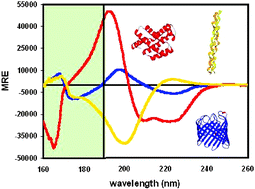The technique of Synchrotron Radiation Circular Dichroism (SRCD) spectroscopy and its advantages over conventional circular dichroism spectroscopy are described in this tutorial review, as well as recent applications of the technique in structural and functional genomics.
Circular dichroism (CD) spectroscopy is a well-established method in biological chemistry and structural biology, but its utility can be limited by the low flux of the light source in the far ultraviolet and vacuum ultraviolet wavelength regions in conventional CD instruments. The development of synchrotron radiation circular dichroism (SRCD), using the intense light of a synchrotron beam, has greatly expanded the utility of the method, especially as a tool for both structural and functional genomics. These applications take advantage of the enhanced features of SRCD relative to conventional CD: the ability to measure lower wavelength data containing more electronic transitions and hence more structural information, the higher signal-to-noise hence requiring smaller samples, the higher intensity enabling measurements in absorbing buffers and in the presence of lipids and detergents, and the ability to do faster measurements enabling high throughput and time-resolved spectroscopy.
This article discusses recent developments in SRCD instrumentation, software, sample preparation and methods of analyses, with particular emphasis on their applications to the study of proteins. These advances have led to new applications in structural genomics (SG), including the potential for fold recognition as a means of target selection and the examination of membrane proteins, a class of proteins usually excluded from SG programmes. Other SG uses include detection of macromolecular interactions as a screen for complex formation, and examination of glycoproteins and sugar components. In functional genomics (FG) new applications include screening for ligand binding as a means of identifying function, and examination of structural differences in mutant proteins as a means of gaining insight into function.


 Please wait while we load your content...
Please wait while we load your content...